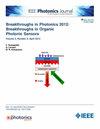Material Gain Simulation of In(As)SbBi Quantum Wells on InSb Substrate for Mid-Infrared Laser Applications
IF 2.4
4区 工程技术
Q3 ENGINEERING, ELECTRICAL & ELECTRONIC
引用次数: 0
Abstract
The mid infrared (mid-IR) spectral range holds significant importance in laser technology because of its unique characteristics and broad range of potential applications, including gas sensing. This paper discusses the possibility of constructing structures for mid-IR lasers operating on the InSb substrate based on interband transitions. The study demonstrates the potential of bismuth-related quantum wells (QWs) and alloyed semiconductor materials for long-wavelength (LWIR) laser applications, providing insight into their electronic properties and potential for device optimization. Gain spectra were calculated for different scenarios, revealing the dominance of TE or TM modes depending on the material composition and carrier concentration. The gain spectrum widens with increasing QW width, and its intensity decreases with the growth of As. The material system under consideration is well suited for the (6–8,中红外激光中InSb衬底上In(As)SbBi量子阱的材料增益模拟
中红外(mid- ir)光谱范围在激光技术中具有重要意义,因为它具有独特的特性和广泛的潜在应用范围,包括气体传感。本文讨论了基于带间跃迁构建在InSb衬底上工作的中红外激光器结构的可能性。该研究证明了铋相关量子阱(QWs)和合金半导体材料在长波激光(LWIR)应用中的潜力,提供了对其电子特性和器件优化潜力的洞察。计算了不同情况下的增益谱,揭示了TE或TM模式的优势,这取决于材料成分和载流子浓度。增益谱随量子阱宽度的增大而变宽,强度随As的增大而减小。所考虑的材料系统非常适合(6-8,$\mu$m)波长范围,可以被认为是LWIR器件的有前途的候选者。
本文章由计算机程序翻译,如有差异,请以英文原文为准。
求助全文
约1分钟内获得全文
求助全文
来源期刊

IEEE Photonics Journal
ENGINEERING, ELECTRICAL & ELECTRONIC-OPTICS
CiteScore
4.50
自引率
8.30%
发文量
489
审稿时长
1.4 months
期刊介绍:
Breakthroughs in the generation of light and in its control and utilization have given rise to the field of Photonics, a rapidly expanding area of science and technology with major technological and economic impact. Photonics integrates quantum electronics and optics to accelerate progress in the generation of novel photon sources and in their utilization in emerging applications at the micro and nano scales spanning from the far-infrared/THz to the x-ray region of the electromagnetic spectrum. IEEE Photonics Journal is an online-only journal dedicated to the rapid disclosure of top-quality peer-reviewed research at the forefront of all areas of photonics. Contributions addressing issues ranging from fundamental understanding to emerging technologies and applications are within the scope of the Journal. The Journal includes topics in: Photon sources from far infrared to X-rays, Photonics materials and engineered photonic structures, Integrated optics and optoelectronic, Ultrafast, attosecond, high field and short wavelength photonics, Biophotonics, including DNA photonics, Nanophotonics, Magnetophotonics, Fundamentals of light propagation and interaction; nonlinear effects, Optical data storage, Fiber optics and optical communications devices, systems, and technologies, Micro Opto Electro Mechanical Systems (MOEMS), Microwave photonics, Optical Sensors.
 求助内容:
求助内容: 应助结果提醒方式:
应助结果提醒方式:


